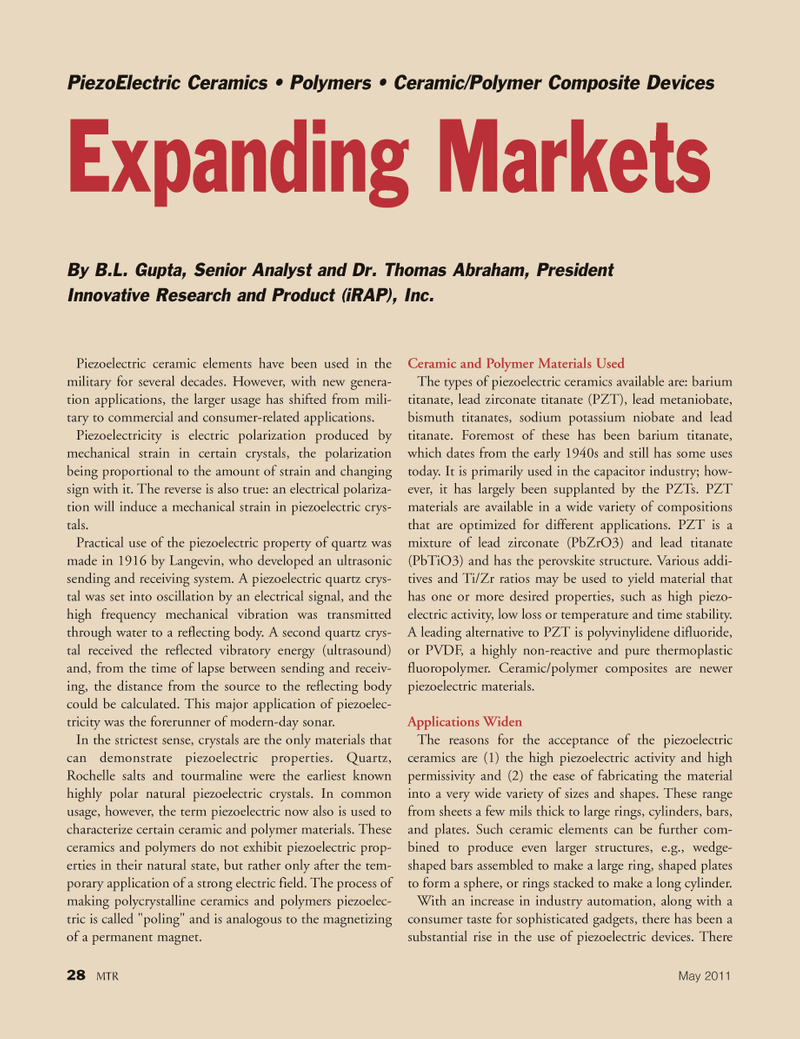
Page 28: of Marine Technology Magazine (May 2011)
Subsea Defense Edition
Read this page in Pdf, Flash or Html5 edition of May 2011 Marine Technology Magazine
28 MTR May 2011
PiezoElectric Ceramics • Polymers • Ceramic/Polymer Composite Devices
Expanding Markets
By B.L. Gupta, Senior Analyst and Dr. Thomas Abraham, President
Innovative Research and Product (iRAP), Inc.
Piezoelectric ceramic elements have been used in the military for several decades. However, with new genera- tion applications, the larger usage has shifted from mili- tary to commercial and consumer-related applications.
Piezoelectricity is electric polarization produced by mechanical strain in certain crystals, the polarization being proportional to the amount of strain and changing sign with it. The reverse is also true: an electrical polariza- tion will induce a mechanical strain in piezoelectric crys- tals.
Practical use of the piezoelectric property of quartz was made in 1916 by Langevin, who developed an ultrasonic sending and receiving system. A piezoelectric quartz crys- tal was set into oscillation by an electrical signal, and the high frequency mechanical vibration was transmitted through water to a reflecting body. A second quartz crys- tal received the reflected vibratory energy (ultrasound) and, from the time of lapse between sending and receiv- ing, the distance from the source to the reflecting body could be calculated. This major application of piezoelec- tricity was the forerunner of modern-day sonar.
In the strictest sense, crystals are the only materials that can demonstrate piezoelectric properties. Quartz,
Rochelle salts and tourmaline were the earliest known highly polar natural piezoelectric crystals. In common usage, however, the term piezoelectric now also is used to characterize certain ceramic and polymer materials. These ceramics and polymers do not exhibit piezoelectric prop- erties in their natural state, but rather only after the tem- porary application of a strong electric field. The process of making polycrystalline ceramics and polymers piezoelec- tric is called "poling" and is analogous to the magnetizing of a permanent magnet.
Ceramic and Polymer Materials Used
The types of piezoelectric ceramics available are: barium titanate, lead zirconate titanate (PZT), lead metaniobate, bismuth titanates, sodium potassium niobate and lead titanate. Foremost of these has been barium titanate, which dates from the early 1940s and still has some uses today. It is primarily used in the capacitor industry; how- ever, it has largely been supplanted by the PZTs. PZT materials are available in a wide variety of compositions that are optimized for different applications. PZT is a mixture of lead zirconate (PbZrO3) and lead titanate (PbTiO3) and has the perovskite structure. Various addi- tives and Ti/Zr ratios may be used to yield material that has one or more desired properties, such as high piezo- electric activity, low loss or temperature and time stability.
A leading alternative to PZT is polyvinylidene difluoride, or PVDF, a highly non-reactive and pure thermoplastic fluoropolymer. Ceramic/polymer composites are newer piezoelectric materials.
Applications Widen
The reasons for the acceptance of the piezoelectric ceramics are (1) the high piezoelectric activity and high permissivity and (2) the ease of fabricating the material into a very wide variety of sizes and shapes. These range from sheets a few mils thick to large rings, cylinders, bars, and plates. Such ceramic elements can be further com- bined to produce even larger structures, e.g., wedge- shaped bars assembled to make a large ring, shaped plates to form a sphere, or rings stacked to make a long cylinder.
With an increase in industry automation, along with a consumer taste for sophisticated gadgets, there has been a substantial rise in the use of piezoelectric devices. There

 27
27

 29
29
